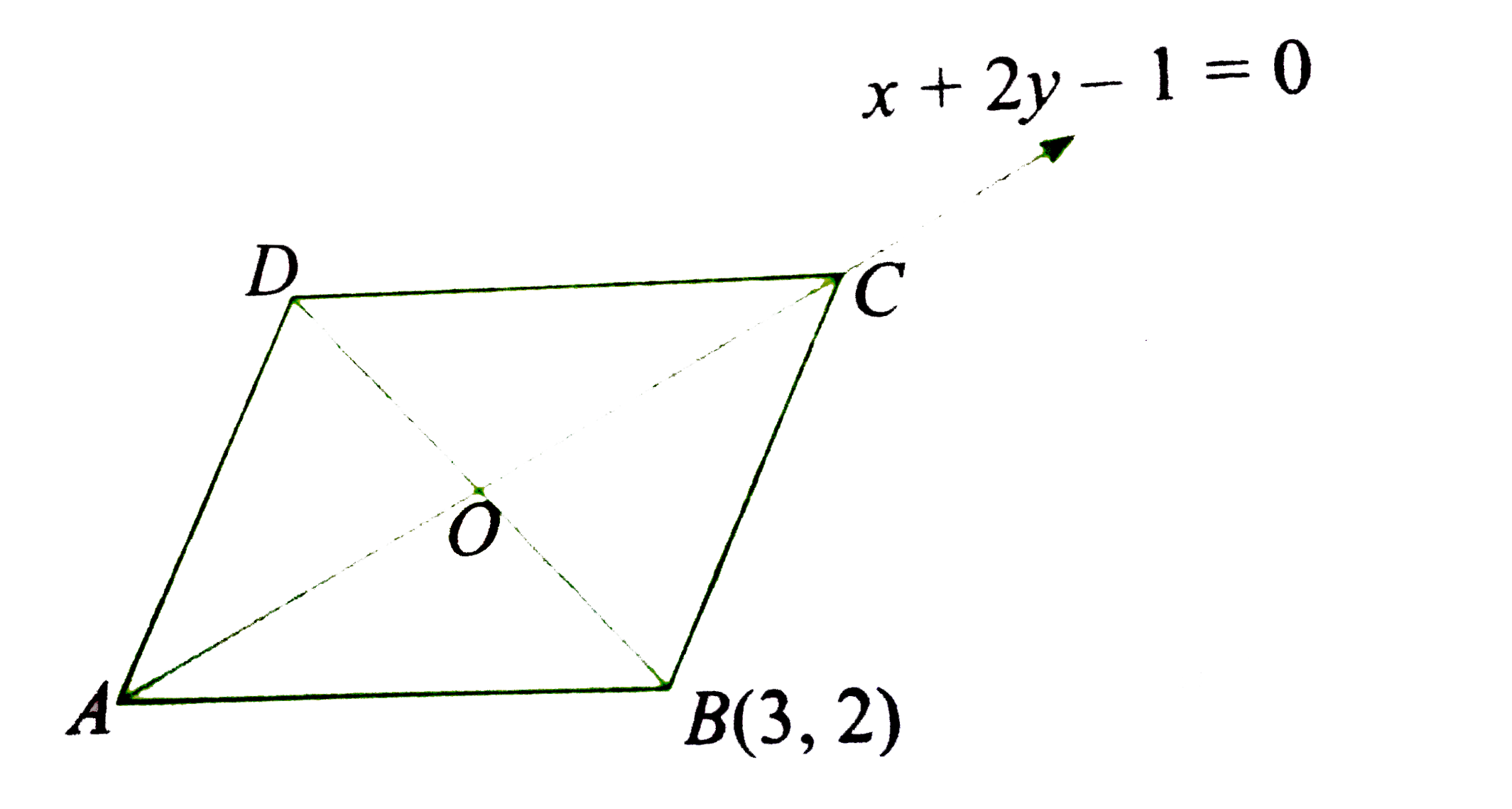A diagonal of rhombus ABCD is member of both the families of lines (x+y−1)+λ1(2x+3y−2)=0and (x−y+2)+λ2(2x−3y+5)=0 and rhombus is (3, 2). If the area of the rhombus is 12√5 sq. units, then find the remaining vertices of the rhombus.Solution in Tamil

Since diagonal is member of both the given families of line, it will pass through the points (1,0) and (-1,1) which are points where given family of lines are concurrent.
So, equation of diagonal AC is x+2y-1=0.
Clearly, point (3,2) does not satisfy this diagonal.
∴LetB≡(3,2).
Diagonal BD is perpendicular to AC.
So, equation of diagonal BD is 2x-y-4=0.
Point of intersection of diagonal AC and BD is O (95,−25).
Since O is midpoint of BD, D ≡(35,−145).
Now,OD=6√5.So,BD=12√5=d1
Area of rhombus =12d1×d2=12√5 (where d2 is length of diagonal AC)
∴d2=10 units
This is the length of diagonal AC.
Slope of AC =−12=tanθ,whereθ is inclination of AC with x-axis.
Since OA=OC=5, using parametic from of straight line, we have
A,C≡(95±5cosθ,−25±5sinθ)
≡(95±5(−2√5),−25±5(1√5))
≡(95−2√5,−25+√5),(95+2√5,−25−√5)
Topper's Solved these Questions
- STRAIGHT LINESBOOK - CENGAGECHAPTER - STRAIGHT LINESEXERCISE - Exercise 2.1
23 Videos
- STRAIGHT LINESBOOK - CENGAGECHAPTER - STRAIGHT LINESEXERCISE - Exercise 2.2
4 Videos
- STRAIGHT LINEBOOK - CENGAGECHAPTER - STRAIGHT LINEEXERCISE - Multiple Correct Answers Type
8 Videos
- THEORY OF EQUATIONSBOOK - CENGAGECHAPTER - THEORY OF EQUATIONSEXERCISE - JEE Advanced Previous Year
9 Videos
Similar Questions
Find the equation of the right bisector of the line segment joining the points (3,4) and (−1,2).
View SolutionFind the points on the line x + y = 1 that lie at a distance 3 units from the line 5x+12y = 3.
View SolutionThe point P(α,α+1) will lie inside the triangle whose vertices are A(0,3),B(−2,0) and C(6,1) if
View SolutionQ. Let p and q real number such that p≠0,p2≠q and p2≠−q. if α and β are non-zero complex number satisfying α+β=−p and α3+β3=q, then a quadratic equation having αβ and βα as its roots is
View SolutionIf the two sides of rhombus are x+2y+2=0 and 2x+y−3=0, then find the slope of the longer diagonal.
View SolutionA diagonal of rhombus ABCD is member of both the families of lines (x+y−1)+λ(2x+3y−2)=0and (x−y+2)+λ(2x−3y+5)=0 and rhombus is (3, 2). If the area of the rhombus is 12√5 sq. units, then find the remaining vertices of the rhombus.
View SolutionShow that the points A(-3, 2), B(-5, -5), C(2, -3) and D(4, 4) are the vertices of a rhombus. Find the area of this rhombus.
View SolutionTwo sides of a rhombus are along the lines x - y + 1 = 0 and 7 x - y - 5 = 0 . If its diagonals intersect at ( - 1, -2) , then which one of the following is a vertex of this rhombus ?
View SolutionThe area of the rhombus ABCD is 24. The equation of the diagonal BD is 4x + 3y + 2=0 and A (3,2) The length of the side of the rhombus is
View SolutionA diagonal of rhombus ABCD is a member of both the family of lines (x+y+1)+λ1(2x+3y−2)=0and(x−y+2)+λ2(2x−3y+5) where λ1,λ2∈ R and one of the vertex of the rhombus is (3,2) . If area of the rhombus is 2√5 square units then find the length of semi longer diagonal of the rhombus ..........
View Solutionএকটি রম্বসের দুটি বাহু x−y+1=0এবং7x−y−5=0সরলরেখাদ্বয়ের অংশবিশেষ। যদি রম্বসের কর্ণদ্বয় (-1, -2) বিন্দুতে ছেদ করে, তাহলে এই রম্বসের একটি শীর্ষবিন্দু হবে নীচের কোনটি?
View SolutionIf the two sides of rhombus are x+2y+2=0 and 2x+y−3=0, then find the slope of the longer diagonal.
View SolutionA diagonal of rhombus ABCD is member of both the families of lines (x+y−1)+λ(2x+3y−2)=0 and (x−y+2)+λ(2x−3y+5)=0 and rhombus is (3, 2). If the area of the rhombus is 12√5 sq. units, then find the remaining vertices of the rhombus.
View SolutionIf the two sides of rhombus are x+2y+2=0 and 2x+y−3=0, then find the slope of the longer diagonal.
View SolutionIf two sides of a rhombus lines x-y +1 =0 And 7x - y 5=0 Is in the direction of and its diagonal point (-1,-2) But the intersection is karte, which of the following vertices of rhombus is
View SolutionThe point of intersection of the diagonals of the rhombus formed by the lines 2x+y−5=0,x+2y+8=0,2x+y+5=0, and x+2y−2=0 is
View Solution
